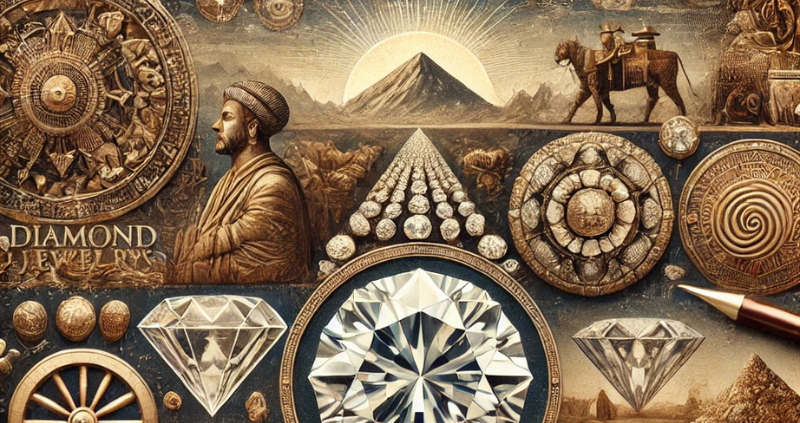History of Diamonds: From Ancient Civilizations to Modern Luxury

Diamonds have fascinated humanity for years, emerging as symbols of power, wealth, and eternal beauty. From their humble beginnings in ancient civilizations to their current status as the epitome of luxury, diamonds have a rich and diverse history that mirrors human ambition and innovation. This article explores the journey of diamonds from their discovery to their role in modern luxury.
1. Diamonds in Ancient Civilizations
The history of diamonds begins in ancient India, where they were first discovered around the 4th century BCE. Indian royalty prized diamonds not only for their beauty but also for their perceived magical properties. They were believed to bring protection from evil spirits and disasters. The Sanskrit text, the Arthashastra, mentions diamonds as early as 320 BCE, detailing their trade and grading.
As the only known source of diamonds for centuries, India became the central hub for the diamond trade. These precious stones were often traded along the Silk Road, reaching far-off lands in Europe and China. Historical texts show that diamonds were worn as talismans and incorporated into royal jewellery.
2. Medieval and Renaissance Europe: Diamonds as Symbols of Power
By the Middle Ages, diamonds had made their way to European courts. Initially due to the lack of understanding of their properties, this perception dramatically changed during the Renaissance when the diamond's rarity and brilliance became more widely appreciated.
Diamonds became a favourite among European monarchs and were considered symbols of power and divine favour. Kings and queens adorned themselves with diamond-encrusted crowns, and garments, establishing diamonds as a status symbol for royalty and nobility.
3. The Discovery of Brazilian Diamonds
For centuries, India remained the only significant source of diamonds until the discovery of vast diamond deposits in Brazil in the early 18th century. This new supply helped meet the increasing demand for diamonds in Europe, particularly among the emerging higher class. Brazilian diamonds were initially dismissed as inferior to Indian diamonds, but over time, their value and quality became recognized, contributing to the global diamond trade.
4. The Diamond Rush: South Africa’s Impact
The modern diamond industry began in South Africa in the late 19th century. In 1867, a young boy found a diamond along the banks of the Orange River, sparking the first diamond rush. Just a few years later, the discovery of massive diamond fields near Kimberley transformed the global market. This led to the establishment of major mining companies, such as De Beers, which would later dominate the industry for decades.
South Africa’s diamond fields significantly increased the availability of diamonds, transforming them from rare gems for the elite into a commodity that could be marketed to the masses. The success of the Kimberley mines and others in the region laid the groundwork for the industrial-scale diamond mining that exists today.
5. The Evolution of Diamond Cutting and Jewellery Design
Throughout history, diamonds were primarily prized in their natural state, with little focus on cutting or shaping. Early gem cutters were reluctant to tamper with diamonds, given their hardness. It wasn't until the 15th century that the first techniques for cutting diamonds were developed in Europe. These early cuts were rudimentary but laid the foundation for the sophisticated cuts we see today.
The 20th century brought significant advancements in diamond cutting, leading to the creation of brilliant cuts that enhanced the diamond's sparkle and symmetry. New technology enabled jewellers to showcase diamonds in intricate settings that reflected modern design trends.
6. The Role of Diamonds in Modern Luxury
Today, diamonds are synonymous with luxury, elegance, and commitment. The diamond engagement ring tradition, popularised by De Beers in the 20th century with the slogan "A Diamond is Forever," cemented diamonds as the ultimate symbol of love and devotion. This marketing campaign was one of the most successful in history, driving a surge in diamond demand that continues today.
Modern diamond jewellery spans a wide range of styles, from timeless solitaire rings to avant-garde designs that push the boundaries of art and fashion. Celebrities and fashion icons continue to drive the diamond trend, often wearing diamond jewellery at red-carpet events, further elevating their status in popular culture.
7. Sustainable and Lab-Grown Diamonds: The Future of Luxury
In recent years, the diamond industry has faced increasing scrutiny regarding ethical and environmental concerns. The rise of conflict-free, ethical diamonds, as well as lab-grown diamonds, has transformed the market. Lab-grown diamonds offer a sustainable alternative, created in controlled environments with the same chemical and physical properties as natural diamonds.
Many luxury brands have embraced these innovations, offering consumers a guilt-free option that aligns with modern values. As consumer preferences evolve, the demand for transparency and sustainability will likely shape the future of the diamond industry.
Conclusion
The history of diamonds is a testament to their enduring appeal across different cultures and time periods. From ancient India’s revered gemstones to modern luxury pieces, diamonds have evolved to reflect the values, tastes, and technologies of each era. Today, diamonds continue to captivate the world, symbolising everything from eternal love to high fashion, and with the rise of ethical and lab-grown options, they are poised to maintain their place in the luxury market for generations to come.
If you are a diamond buyer or seller and want to connect with the best traders in the industry, consider downloading the GA Demands app. With no middlemen and no transaction fees, our platform ensures you find the best deals while expanding your network. Like, Follow, Comment, Share, and Download the GA Demands app today to elevate your diamond trading experience!

